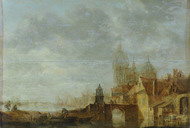Events / Exhibitions
12.12.2019 - 20.02.2020
The Orient and Armenian Art
Cultural interconnection is one of the urgent issues of the contemporary art; it makes a powerful key impetus for the development of culture. In the East-West crossroads Armenia has long ago been closely connected with Ancient Orient and ancient civilizations. This has made the country one of the most interesting points of the union of various cultural aspects. Armenia has played a greatest role in the formation of Christian world perception.
Each historic period while changing the fortune and spiritual cue of Armenia has in its own way been expressed in artworks. These works characterized by invariable traits peculiar for the national thinking nevertheless preserve the artistic features of East and West. The selected works on oriental subject and those by the artists housed in the Gallery gives a certain opportunity to draw parallels and make a comparative analysis among works of various art schools. The displayed works not always represent a complete scope, though the conception of the exhibition and the criteria of the selection contribute to the revelation of artistic relations between Armenian art and Near East, Middle East and Far East countries, illustrating ongoing process of art evolution.
The exhibition “The Orient and Armenian Art” is a comprehensive and multi-layer exhibition. Along with medieval monuments, miniatures and murals, art of the new period, including portraits of the Hovnatanians, the art heritage of Armenian classic artists and works of contemporary masters are on display.
The subject of the Orient is the integral part of the creative activity of V. Sureniants, H. Kojoyan, M. Sarian, G. Yakulov and H. Ter-Tadevossian. In the works of others including Y. Kochar and M. Aslamazian the subject is often expressed mediated and sometimes clearly.
The art of the second half of the 20th - early 21st centuries, including A. Hovhannisyan, M. Avetisyan, K. Vardanyan, Hagop Hagopian, S. Khatlamajyan, R. Elibekyan, M. Petrosyan, E. Kharazyan, A. Bayandour, Raffi Adalyan and Hrachya Hakobyan express the traditions of the national school united with avant-garde tendencies, which renew the expressive means of the Armenian contemporary art. It contains a vivid eastern component that becomes unveiled with a wider implication.
The exhibition also represents artists active in the countries of Western and Southeast Asia. They have managed to interpret the countries-old culture of the continent in their own way. Armenian artists of Tbilisi are worth special attention. In their original expressive means they have reflected the colourful atmosphere of multi nation city uniting Christian traditions and culture of the Orient. The latter is treated here not as an alien and exotic phenomenon, but as a whole part of their lifestyle.
A. Bazhbeuk-Melikian, H. Karalian, V. Elibekyan, G. Khachatryan and S. Parajanov; these names make the pleiad of brilliant masters that have formed a specific direction of the national painting school.
The exhibition also includes works of contemporary artists of various generations and following various stylistic directions; those artists are united with expressions of oriental art. This is not a cultural impact of a separate country, a stylization or a mechanical use of artistic means, but it is more like a wider view of things, thinking and world outlook striking by specific interpretation of familiar things. This is an exclusive skill of correlation of diverse artistic phenomena, the ability of attaching freshness and new sonority to them. These correlations of the general and the unique, the past and the present appear in the expressive compositions of Ruben Adalyan, in the works of Hagop Hagopian, strict and laconic in expressive language, in colourful works of R. Elibekyan, drawn to abstraction, and in those of M. Petrosyan, inspired with mystic mood. Those correlations are obviously expressed in effulgent and rich paintings of E. Vardanyan, in the harmonious artistic world of R. Megall, associated with ancient murals as well as in the papers of A. Haytayan, ephemeral, deprived of the Earth’s gravity.
The expressions of the spirit of the Orient are diverse; they can be seen also in sensual and subtle figures of oriental beauties brushed by T. Matulyan, as well as in the self-immersed and introspective pictures done by Z. Bazhbeuk-Melikian - the representative of the Bazhbeuk-Melikian family.
The presented paintings together with graphic papers and items of sculpture and decorative-applied art unveil the complicated ways of interchange of art information that have nowadays become rapid; they arouse our imagination and widen the borders of contemporary culture.
